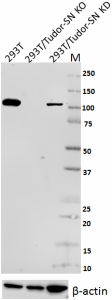- Clone
- 13.14.1 (See other available formats)
- Regulatory Status
- RUO
- Other Names
- SND1, TDRD11, Staphylococcal nuclease domain-containing protein 1, 100 kD coactivator, p100
- Isotype
- Mouse IgG1, κ

-

Total lysates (15 µg protein) from 293T, 293T/Tudor-SN CRISPR/Cas9 knockout (KO) and 293T/Tudor-SN knockdown (KD) cells were resolved by electrophoresis (4-20% Tris-Glycine gel), transferred to nitrocellulose, and probed with 1:500 diluted (1 µg/mL) purified anti-Tudor-SN antibody, clone 13.14.1 (upper). Proteins were visualized using chemiluminescence detection by incubating with 1:3000 dilution of HRP goat anti-mouse-IgG secondary antibody (Cat. No. 405306). 1:2000 dilution of Direct-Blot™ HRP anti-β-actin Antibody (Cat. No. 643807) was used as a loading control (lower). Lane M: MW ladder.
| Cat # | Size | Price | Quantity Check Availability | ||
|---|---|---|---|---|---|
| 690002 | 100 µg | $229.00 | |||
Tudor-SN, also called SND1 or p100, is a multifunctional protein. It has been identified in mammals, fish, Drosophila, Caenorhabditis elegans, ciliates and fission yeast, but not in bacteria. It was first characterized as a co-activator of Epstein-Barr virus nuclear protein 2, and subsequently found to interact with other transcription factors such as c-Myb, Pim-1, STAT6, and STAT5. Tudor-SN regulates pre-mRNA splicing through interacting with components of the spliceosome. Many studies also demonstrate that Tudor-SN potentially participates in the cell cycle regulation.
Studies have illustrated the significant association of Tudor-SN with different types of cancers, such as liver, breast, prostate and colorectal cancers and malignant glioma. It is overexpressed in these cancers and known to promote carcinogenesis.
Product Details
- Verified Reactivity
- Human, Mouse
- Antibody Type
- Monoclonal
- Host Species
- Mouse
- Immunogen
- C-term region (698-910 a.a.)
- Formulation
- Phosphate-buffered solution, pH 7.2, containing 0.09% sodium azide.
- Preparation
- The antibody was purified by affinity chromatography.
- Concentration
- 0.5 mg/ml
- Storage & Handling
- The antibody solution should be stored undiluted between 2°C and 8°C.
- Application
-
WB - Quality tested
KO/KD-WB - Verified - Recommended Usage
-
Each lot of this antibody is quality control tested by Western blotting. For Western blotting, the suggested use of this reagent is 0.5 - 2.5 µg per ml. It is recommended that the reagent be titrated for optimal performance for each application.
-
Application References
(PubMed link indicates BioLegend citation) -
- Ota H, et al. 2013. Cell. 153:575.
- RRID
-
AB_2629792 (BioLegend Cat. No. 690002)
Antigen Details
- Structure
- 910 amino acid with a predicted molecular weight of 102kD, but can be observed at ~110 kD due to post transitional modifications.
- Distribution
-
Cytoplasm, nucleus and melanosome.
- Function
- Bridging factor between STAT6 and the basal transcription factor; PIM1 regulation of MYB activity; transcriptional coactivator for the Epstein-Barr virus nuclear antigen 2.
- Interaction
- EBNA2, EAV NSP1, GTF2E1, GTF2E2, STAT6, POLR2A and STAT5.
- Biology Area
- Cell Biology, Transcription Factors
- Antigen References
-
1. Li CL, et al. 2008. Nucleic Acids Res. 36:3579.
2. Caudy AA, et al. 2003. Nature. 425:411.
3. Howard-Till RA, et al. 2007. Cell. 6:1795.
4. Tong X, et al. 1995. Mol. Cell. Biol. 15:4735.
5. Su C, et al. 2015. J. Biol. Chem. 290:7208.
6. Leverson JD, et al. 1998. Mol. Cell. 2:417.
7. Yang J, et al. 2002. EMBO J. 21:4950.
8. Jariwala N, et al. 2015. Int. J. Oncol. 46:465. - Gene ID
- 27044 View all products for this Gene ID
- UniProt
- View information about Tudor-SN on UniProt.org
Other Formats
View All Tudor-SN Reagents Request Custom Conjugation| Description | Clone | Applications |
|---|---|---|
| Purified anti-Tudor-SN | 13.14.1 | WB,KO/KD-WB |
Compare Data Across All Formats
This data display is provided for general comparisons between formats.
Your actual data may vary due to variations in samples, target cells, instruments and their settings, staining conditions, and other factors.
If you need assistance with selecting the best format contact our expert technical support team.
-
Purified anti-Tudor-SN

Total lysates (15 µg protein) from 293T, 293T/Tudor-SN CRISP...
